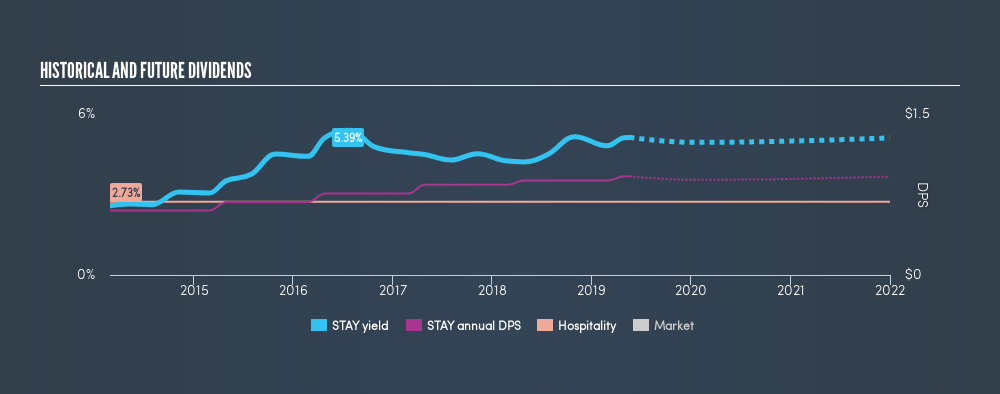Three Things You Should Check Before Buying Extended Stay America, Inc. (NASDAQ:STAY) For Its Dividend

Could Extended Stay America, Inc. (NASDAQ:STAY) be an attractive dividend share to own for the long haul? Investors are often drawn to strong companies with the idea of reinvesting the dividends. If you are hoping to live on your dividends, it's important to be more stringent with your investments than the average punter. Regular readers know we like to apply the same approach to each dividend stock, and we hope you'll find our analysis useful.
In this case, Extended Stay America likely looks attractive to dividend investors, given its 5.1% dividend yield and five-year payment history. We'd agree the yield does look enticing. The company also bought back stock during the year, equivalent to approximately 1.5% of the company's market capitalisation at the time. Before you buy any stock for its dividend however, you should always remember Warren Buffett's two rules: 1) Don't lose money, and 2) Remember rule #1. We'll run through some checks below to help with this.
Explore this interactive chart for our latest analysis on Extended Stay America!

Want to participate in a short research study? Help shape the future of investing tools and you could win a $250 gift card!
Payout ratios
Dividends are typically paid from company earnings. If a company pays more in dividends than it earned, then the dividend might become unsustainable - hardly an ideal situation. As a result, we should always investigate whether a company can afford its dividend, measured as a percentage of a company's net income after tax. In the last year, Extended Stay America paid out 80% of its profit as dividends. It's paying out most of its earnings, which limits the amount that can be reinvested in the business. This may indicate limited need for further capital within the business, or highlight a commitment to paying a dividend.
We also measure dividends paid against a company's levered free cash flow, to see if enough cash was generated to cover the dividend. The company paid out 82% of its free cash flow as dividends last year, which is adequate, but reduces the wriggle room in the event of a downturn.
Is Extended Stay America's Balance Sheet Risky?
As Extended Stay America has a meaningful amount of debt, we need to check its balance sheet to see if the company might have debt risks. A quick way to check a company's financial situation uses these two ratios: net debt divided by EBITDA (earnings before interest, tax, depreciation and amortisation), and net interest cover. Net debt to EBITDA measures a company's total debt load relative to its earnings (lower = less debt), while net interest cover measures the company's ability to pay the interest on its debt (higher = greater ability to pay interest costs). Extended Stay America is carrying net debt of 3.72 times its EBITDA, which is getting towards the upper limit of our comfort range on a dividend stock that the investor hopes will endure a wide range of economic circumstances.
Net interest cover can be calculated by dividing earnings before interest and tax (EBIT) by the company's net interest expense. Interest cover of less than 5x its interest expense is starting to become a concern for Extended Stay America, and be aware that lenders may place additional restrictions on the company as well.
We update our data on Extended Stay America every 24 hours, so you can always get our latest analysis of its financial health, here.
Dividend Volatility
One of the major risks of relying on dividend income, is the potential for a company to struggle financially and cut its dividend. Not only is your income cut, but the value of your investment declines as well - nasty. Looking at the data, we can see that Extended Stay America has been paying a dividend for the past five years. During the past five-year period, the first annual payment was US$0.60 in 2014, compared to US$0.92 last year. Dividends per share have grown at approximately 8.9% per year over this time.
The dividend has been growing at a reasonable rate, which we like. We're conscious though that one of the best ways to detect a multi-decade consistent dividend payer, is to watch a company pay dividends for 20 years - a distinction Extended Stay America has not achieved yet.
Dividend Growth Potential
Examining whether the dividend is affordable and stable is important. However, it's also important to assess if earnings per share (EPS) are growing. Growing EPS can help maintain or increase the purchasing power of the dividend over the long run. Strong earnings per share (EPS) growth might encourage our interest in the company despite fluctuating dividends, which is why it's great to see Extended Stay America has grown its earnings per share at 19% per annum over the past five years. Earnings per share are growing nicely, but the company is paying out most of its earnings as dividends. This might be sustainable, but we wonder why Extended Stay America is not retaining those earnings to reinvest in growth.
Conclusion
To summarise, shareholders should always check that Extended Stay America's dividends are affordable, that its dividend payments are relatively stable, and that it has decent prospects for growing its earnings and dividend. First, we think Extended Stay America is paying out an acceptable percentage of its cashflow and profit. Next, earnings growth has been good, but unfortunately the company has not been paying dividends as long as we'd like. Ultimately, Extended Stay America comes up short on our dividend analysis. It's not that we think it is a bad company - just that there are likely more appealing dividend prospects out there on this analysis.
Earnings growth generally bodes well for the future value of company dividend payments. See if the 9 Extended Stay America analysts we track are forecasting continued growth with our free report on analyst estimates for the company.
If you are a dividend investor, you might also want to look at our curated list of dividend stocks yielding above 3%.
We aim to bring you long-term focused research analysis driven by fundamental data. Note that our analysis may not factor in the latest price-sensitive company announcements or qualitative material.
If you spot an error that warrants correction, please contact the editor at editorial-team@simplywallst.com. This article by Simply Wall St is general in nature. It does not constitute a recommendation to buy or sell any stock, and does not take account of your objectives, or your financial situation. Simply Wall St has no position in the stocks mentioned. Thank you for reading.
Market Insights
Community Narratives



